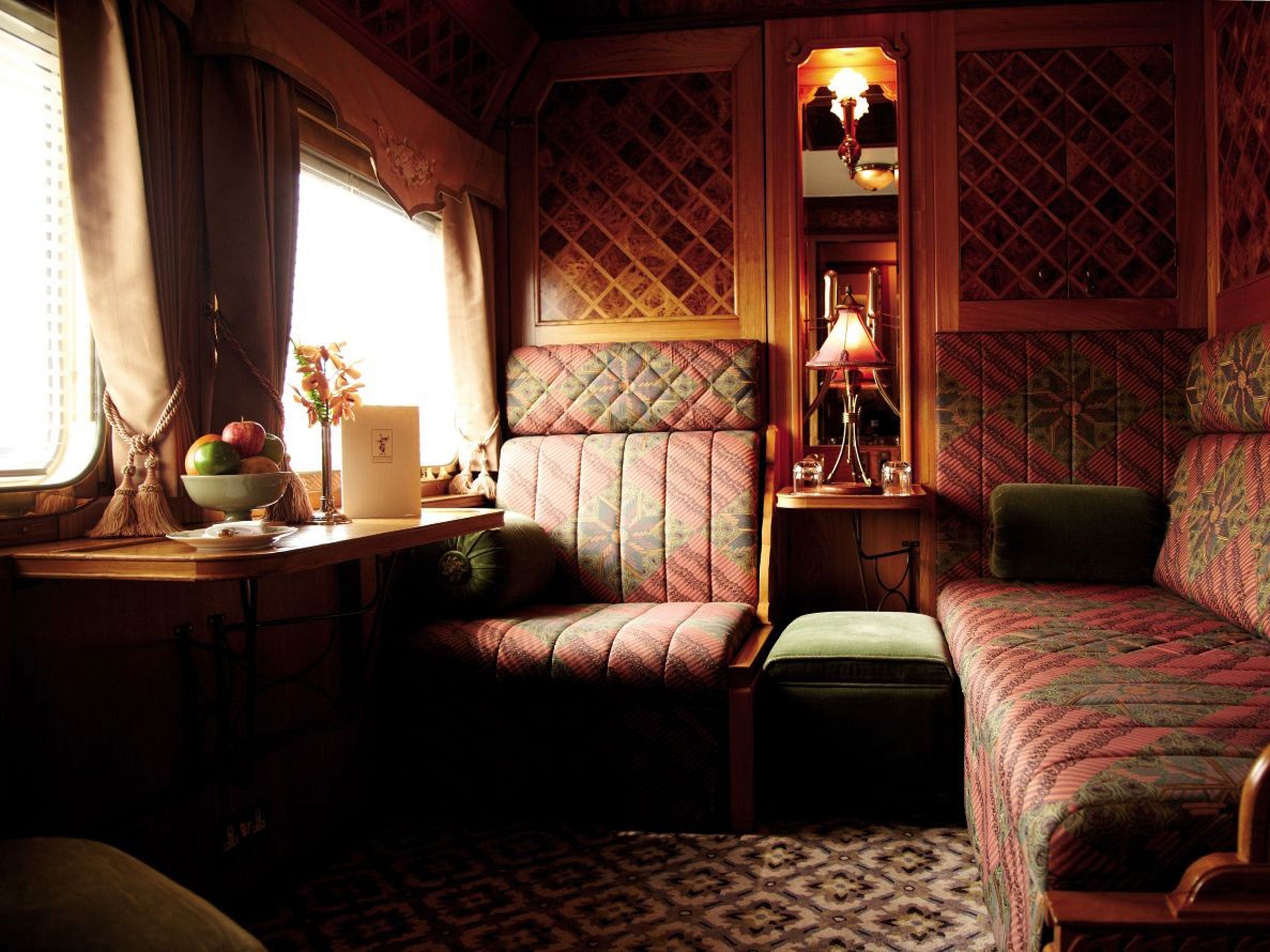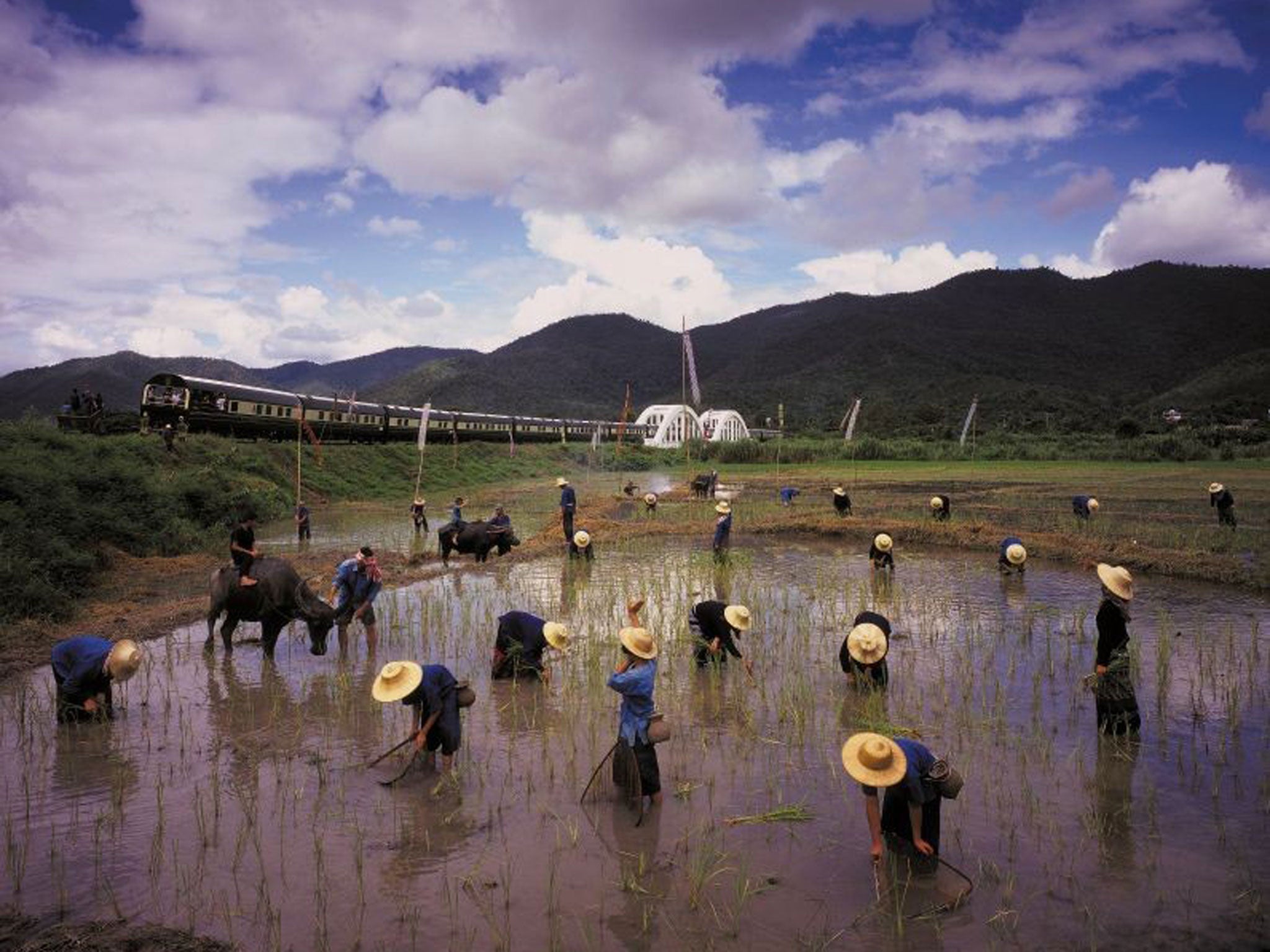Laos: Slow train to the land that time forgot
For now, there's only one international rail route into the seductively secluded nation. Michael Williams steps aboard the luxurious Eastern and Oriental Express
Whoops … here's a crystal glass of claret sailing across the restaurant car's starched white tablecloth, heading straight for my lap. Hold tight … there goes my steaming bowl of soup volleying the other way. It's not normally like this, aboard what has long been one of the most luxurious trains in the world. But today the Eastern and Oriental Express, Asian sister of the famed London-Venice service, is off on an exotic adventure – and it feels like a ship at sea.
After two decades plying serenely and luxuriously between Bangkok and Singapore, this grande dame of international travel has gathered up her skirts and today is heading north towards Laos. At the end of the line awaits one of the world's last remaining Communist states and a last chance to catch a glimpse of the dreamy old Indochina, immortalised by Graham Greene and Somerset Maugham, before it finally vanishes.
For now, there are more pressing issues aboard this first international train to venture across the Lao border for over a year. It becomes clear after we pull out of Bangkok's Hua Lamphong terminus, that there's a mismatch between the majesty of this grand 19-coach sleeping car express – all polished brass and fresh green and cream paintwork – and the rickety narrow gauge tracks of the North-East line of Thai State Railways. Although the rails northwards to the Lao border were laid by the cream of Britain's Victorian civil engineers, it appears that maintenance has been somewhat lacking in the 100 years since.
Naturally, nobody is flustered – nor, in Orient Express world, should you expect them to be. French chef Yiannis emerges coolly from the kitchen car and reports proudly that although he and his sous-chefs have just cooked a feast of rich coconut broth, roast duck breast with tom yam ratatouille and mango parfait for 33 passengers, they haven't spilt even a tiny drop.
Back in my cabin, Funon, my personal steward, is calmly arranging a vase of fresh frangipani and giving a final buff to the cherrywood and elm panelling before turning down my bed for the night. Still, he cannot resist having an Annie and Clarabel moment – tutting like the complaining carriages from Thomas the Tank Engine: "These clumsy drivers. Only fit for freight trains!" he tells me. "They should have more respect for a worthy train such as this."
But venturing along the overgrown rails of a single-track railway through the tropical jungle into the mountains on the borderlands of nowhere, has many charms beyond luxury and service. As the haze of a warm evening fades into night, I loll at the rails of the open-air car at the back of the train with a large Singapore sling in hand, enjoying fleeting moments of intimacy with a world we can only momentarily enter. Winking lights of signals and the lights of tiny stations flash by – and then there's the sour-sweet smell of wood smoke on the air and a thousand meals cooking. Children in tiny trackside hamlets wave like crazy, their barking dogs vainly chasing the rear lights of the train.
I fall asleep in my berth dreaming of fierce tigers, venomous snakes and other menacing creatures of the tropical night that may be prowling alongside the tracks. But when I wake early it is not due to night-time terrors or even the bumps in the rails. Soon after breakfast we'll have the thrill of crossing the Friendship Bridge across the Mekong, built by the Australians in 1994 to link Laos to the outside world.
There can be few more dramatic rail border crossings anywhere. It is an operatic moment as white-jacketed guards hold up the traffic and the grandest of trains swings on to tracks in the middle of the road, marching its carriages over the plum-sauce waters of the mighty Mekong below.

But hold on – not for nothing does Laos have a reputation as the "land that time forgot". Within minutes we are disembarking at the official entry point at Thanaleng station, whose charmless "People's Republic" architecture sets it out as a place not to linger. Unfortunately, the man with the stamp for the passports seems to have forgotten to get out of bed and there's a half-hour wait until he arrives panting and rubbing the sleep from his eyes.
Maybe he thinks it's not important, since the rails peter out abruptly at the buffer stops here. In the half-century the French ruled Laos as a colonial power they never thought it worthwhile spending precious francs on railways in this poverty-stricken, land-locked country – whose main strategic function was keeping the British out. Apart from one tiny line linking islands in the Mekong (now closed), the two miles of track between here and the Friendship Bridge are the only railways that Laos has ever had.
But we mustn't complain. Let's for the moment be thankful for the missing bit of railway, the bus ride over potholed roads to the capital Vientiane and the precipitous flight across the mountains to our ultimate destination. The hard road to dreamy Luang Prabang has helped preserve this soporific mountain kingdom as one of the most beautiful cities in the world – a Unesco World Heritage site that has not yet been ruined by tourism, pollution and the motor car. You can quite believe the legend that the place was founded 1,000 years ago simply because the Buddha smiled when he stopped here to rest one day.
Cradled in a ring of misty mountains and lapped by the lazy waters of the Mekong, this peaceful place of golden temples, humming saffron-robed monks, flower-filled streets and faded old colonial shop fronts is heavy with the magic of the past.
The one-time capital sports a lavish royal palace, built in the French colonial era. It has more than 80 much older temples, some dating back to the 16th century. But perhaps the grandest address is the five-star Résidence Phou Vao, the poshest hotel in town where you can indulge in a refreshing (and expensive) Laotian massage in the spa.
But there's another, simpler pleasure to be found by slipping anonymously into the back streets and cobbled lanes that echo with the shrieks of children and the neighbourhood gossip of the day. Nearby in shady cafés on the banks of the Mekong, groups of wizened men sit puffing on strong tobacco and sipping glasses the powerful Lao coffee. "The only good thing the French ever brought us," snorts the owner of one of the little makeshift cafés under the shady trees on the river bank.
Gourmets, meanwhile, will hail a tuk-tuk and follow the locals to Talad Phosy, a vast market on the edge of town. Almost everything on the planet that walks, hops, wriggles and squirms is laid out on an acre of stalls in a glistening, slobbering, writhing mass of colour.
Here are jumping green toads, glistening pink crabs, wriggling basket loads of live grubs and slithery silver fish swimming furiously in vast buckets – as well as all sorts of vivid crimson innards, entrails and guts. The polythene bags of fresh blood and bile are not for me, but no doubt will grace somebody's supper plate tonight.
Better still, for early-risers there's even a chance of getting get a foothold on the ladder to paradise. Hopeful, I set the alarm for 5am and slip out into dawn mist to join the local ritual of tak da, in which saffron-clad columns of monks file through the early morning streets to be given alms in the form of handfuls of the Lao staple food – sticky, glutinous rice. The idea, in Buddhist thinking, is that you "make merit", accumulating bonus points when you are reborn in your next life.
Sadly, I fluff my chance of nirvana when my gift proves a little too sticky and blobs to the ground, missing the monk's proferred bowl – although everyone seems too spiritually absorbed to notice.

All the more reason then to enjoy soporific, sensuous Luang Prabang while you can, for the modern world is fast approaching. The airlines are busy stepping up their services to the modern international airport on the edge of town. (It's already possible to fly here from London via Bangkok in a day.) In some of the ancient monasteries I notice that the monks are already flashing their iPads and Galaxies. And soon Laos seems destined to get its railways after all – not rickety tracks through the jungle, but one of the most advanced high-speed lines in the world.
This autumn , the government signed a deal with the Chinese to build a new high-speed railway direct from Kunming, in China's southern Yunnan province, via Luang Prabang and Vientiane to Bangkok. If it goes ahead, the 296-mile line will be one of the worlds' most dramatic civil engineering projects, taking 50,000 Chinese workers five years to build.
Two thirds of the route will run on soaring bridges or deep underground in tunnels – which, laid end to end, would be further than digging from Japan to Korea.
As the new trains glide smoothly at up to 240mph through the Lao mountains, you can be certain that not a drop of soup will be spilt. But I'm also as sure as can be that the trip will never be as thrilling, exotic and romantic as the day the Orient Express came to Laos.
Michael Williams' newest book 'The Trains We Have Lost' will be published by Preface, a division of Penguin Random House, in spring 2015.
Travel essentials
Getting there
Michael Williams travelled with Cox & Kings (020 7873 5000; coxandkings.co.uk), which offers an eight-day trip priced from £4,795pp, including two nights’ B&B at the Mandarin Oriental Bangkok, the two-night full board “Tales of Laos” trip on the Eastern & Oriental Express to Vientiane, and two nights’ B&B at La Residence Phou Vao, in Luang Prabang. Flights from Heathrow with Eva Air to Bangkok and transfers are also included. The next trip departs 6 October 2014.
More information
The Foreign Office warns: “A number of political demonstrations have taken place in parts of Bangkok ... You should avoid all protests, political gatherings and demonstrations.”
Join our commenting forum
Join thought-provoking conversations, follow other Independent readers and see their replies
Comments